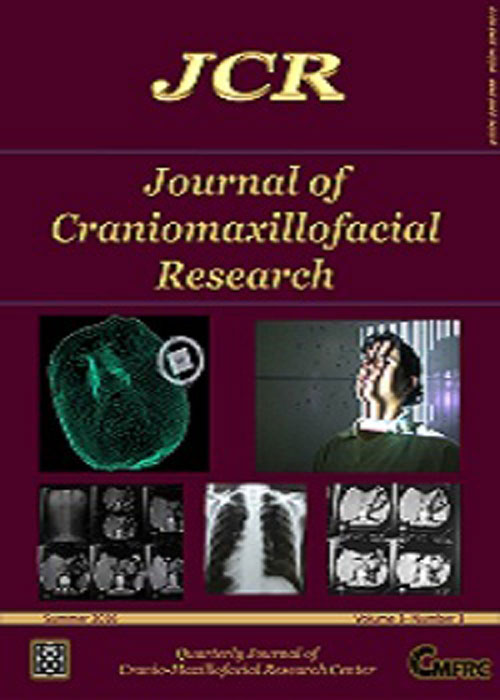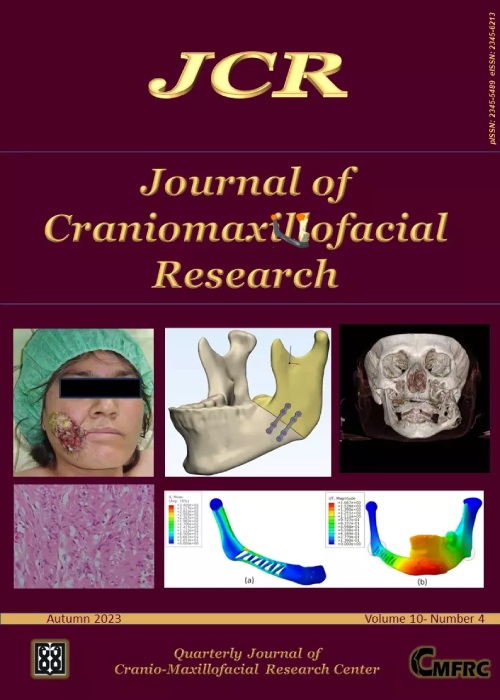فهرست مطالب

Journal of Craniomaxillofacial Research
Volume:3 Issue: 1, Winter 2016
- تاریخ انتشار: 1394/12/20
- تعداد عناوین: 5
-
-
Pages 151-156IntroductionUse of adipose-derived stem cells (ADSCs) is a suggested hypothesis to enhance the regeneration of bone defects. This technique is of particular interest since ADSCs are more easily accessible via a non-invasive harvesting technique compared to bone marrow stem cells (BMSCs). This study sought to assess the efficacy of ADSC implantation for regeneration of localized mandibular bone defects.Materials And MethodsEight patients (six females and two males) between 18 and 28 years with indication for extraction of all four third molars were enrolled in this split-mouth randomized clinical trial. A total of 16mandibular bone defectswere divided into two groups of experimental and control. Cell-containing and cell-free scaffolds were used in the experimental and control groups, respectively. Size of bone defects and percentage of the newly formed bone were assessedi mmediately after surgery and at two, four and six months post-operatively.ResultsNo statistically significant difference was foundin bone regeneration between the two groups at the afore-mentioned time points. However, at all time points in both sides (with and without ADSCs), bone regeneration significantly increased over time (PConclusionThe efficacy of ADSC-containing scaffold was similar to that of cell-free scaffold for enhancing the regeneration of bone defects. Further investigations are required to assess the efficacy of stem cells of different origins in combination with different scaffolds in this regard.Keywords: Stem cells, Bone defects, Mandible, Adipose, derived stem cells
-
Pages 157-160IntroductionRecurrent aphthous stomatitis (RAS) is a common disease with unknown etiology and no treatment. The purpose of this study is to assess the relationship between serum antioxidants level and clinical manifestation. Change in antioxidant level can lead inflammatory reaction through oxidative stress.Materials and MethodsA total 50 patients were selected for this cross sectional study. Superoxide dismutase (SOD), glutathione peroxidase (GSHPX) and total antioxidant status (TAS) was measured in plasma. Also pain intensity based on the visual analogue scale (VAS), the mean interval between lesion, number of lesions and the mean duration of complete healing were recorded. Statistical analysis was performed by using spearman, chi square and T-test.ResultsWe had 50 patients include 28 female and 22 male. Mean and standard deviation was for TAS (1.35±0.15), GPX (178.42±39.67) and SOD (257.86±63.17). Number of lesion and duration of RAS had direct relationship with pain severity. Pain intensity and GPX and SOD were significant (respectively 0.05, 0.04). GPX and SOD level was indirectly related (p=0.04).ConclusionWe could show that RAS patients had alteration in SOD and GPX level but TAS level was stable. Against TAS level which had no change, with more lesion and severe pain GPX level is lower and SOD level was higher. These two antioxidants were related indirectly.Keywords: Recurrent aphthous stomatitis, Antioxidants, Symptoms, Superoxide dismutase (SOD), glutathione peroxidase (GSHPX), total antioxidant status (TAS)
-
Pages 161-165IntroductionPemphigus comprises a group of diseases characterized by cutaneous and mucosal blistering. Pemphigus vulgaris (PV) is the most common and important variant. Recent reports have revealed the relatively high incidence of PV in Iran. The onset or aggravation of many human diseases is attributed to oxidative stress and it has been suggested as one of the several factors responsible for etiopathogenesis of pemphigus. The present study sought to assess the association of salivary level of antioxidant enzyme glutathione peroxidase (GPx) and total antioxidant level with pemphigus vulgaris.Materials And MethodsThis case-control study evaluated patients referred to Razi Dermatology Hospital in Tehran , Iran from January to November 2011. Thirty patients with early diagnosed PV, who had never been on treatment were enrolled in this study. The diagnosis of PV was confirmed by histopathology and direct immunofluorescence. The control group consisted of 30 age- and sex-matched healthy non-smoker volunteers. Saliva was collected from subjects for evaluation of glutathione peroxidase and total antioxidant levels and comparison with controls. GPX and TAS activity was analyzed by spectrophotometry . Independent samples t-test was applied to compare the means of continuous variables. Statistical analysis was performed using SPSS software. P ≤ 0.05 was considered significant.ResultsThe mean salivary level of glutathione peroxidase was significantly lower in pemphigus patients. No statistically significant difference was observed between the groups in total antioxidant levels of saliva.ConclusionOur findings indicated that lower levels of glutathione peroxidase may be associated with pemphigus vulgaris. Salivary GPx level may be used for diagnosis of PV.Keywords: Antioxidant, Pemphigus vulgaris, Glutathione peroxidase
-
Pages 166-171IntroductionAlthough oral cancer is amenable for early detection, it often presents as advanced disease in many of patients. Long-lasting ulcer or mucosal discoloration has been described as the key to an early diagnosis; however other symptoms may also exist. The present study aims to describe the frequency of the early symptoms in oral cancer patients, with a special focus on pain.Materials And MethodsPatients (n=100) with primary oral squamous cell carcinoma (SCC) treated in three university hospitals during 2004-2006, in Tehran, were included in this study. Oral cancers were defined as SCCs of the oral cavity (ICD-10 anatomical sites C01- 06). Questionnaireinterviews were made and all the patient records were reviewed for retrieving data. Data analysis was done by means of SPSS version 20, by Chi-squared test and multinomial regression.ResultsMajority of patients (73%) reported to have painless ulcer as the first symptom. Pain was reported to be the earliest symptom in 10% of oral cancer patients. Other symptoms were swelling, white patch, and paresthesia. Stage of tumor at the time of diagnosis and source of referral were related to initial symptom (pConclusionThis study supports the importance of initial symptoms in the detection of oral cancers in the earliest stage, in order to improve patients prognosis and quality of life.Keywords: pain, Iran, oral cancer, early symptom
-
Pages 172-176Myofibroma is an uncommon benign mesenchymal neoplasm. Solitary myofibroma is common in soft tissues of head and neck, but rare in the jaw bones. Only a few sporadic cases of solitary myofibroma of mandible have been described. The aim of the present study was to present a clinical case of a patient with a myofibroma in mandible bone and its management. Differentiating this lesion from other benign and malignant neoplasms is crucial in deciding between a radical and a conservative treatment approach. We explained that diagnosis of myofibroma can be reached by a histopathologic and immunohistochemical analysis and surgical excision is the treatment of choice.Keywords: Intraosseous, Mandible, Myofibroma


